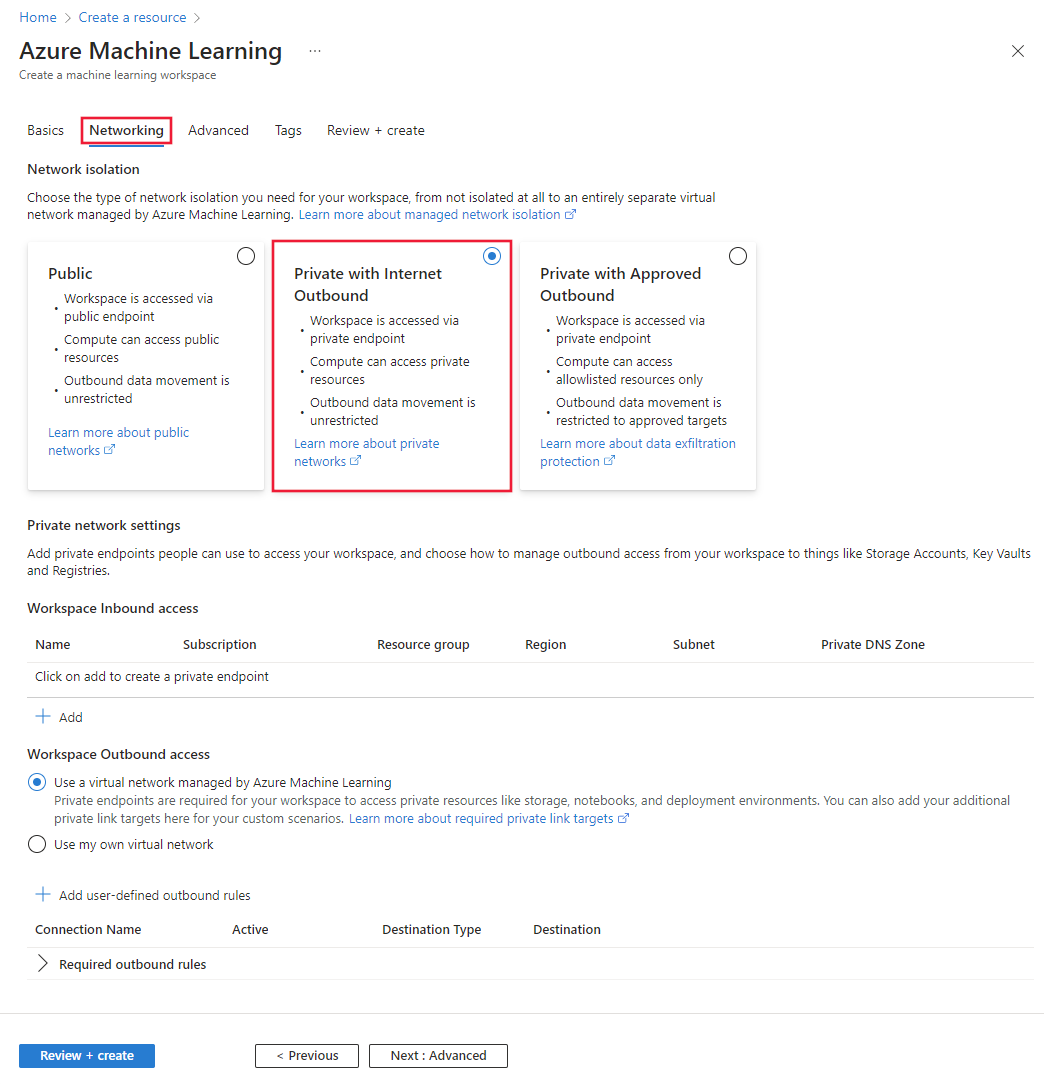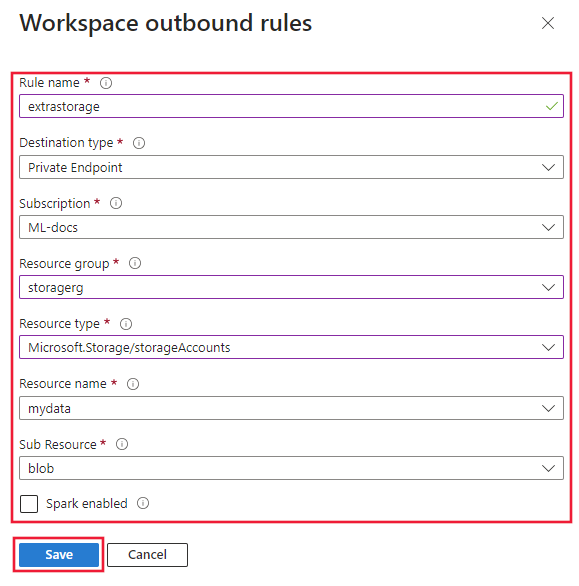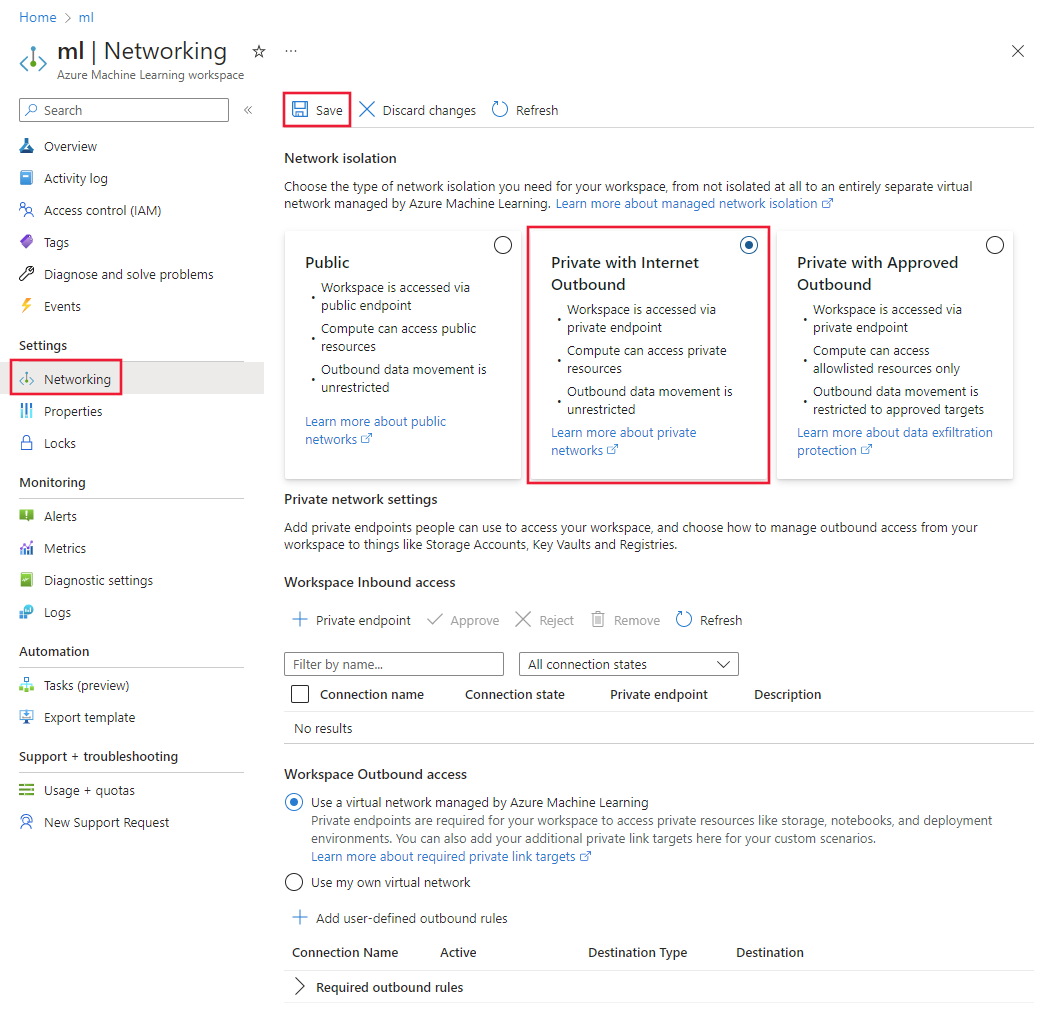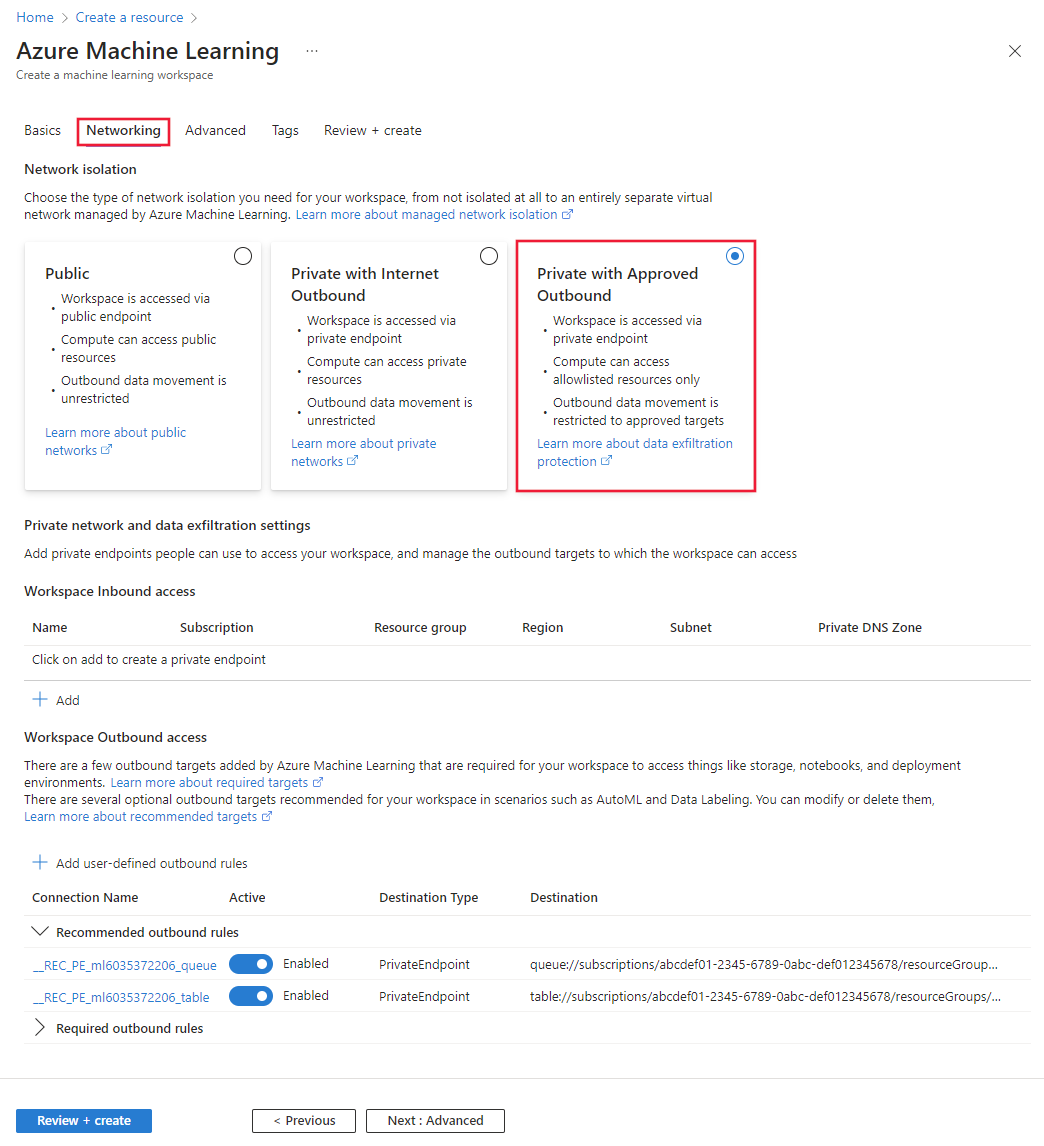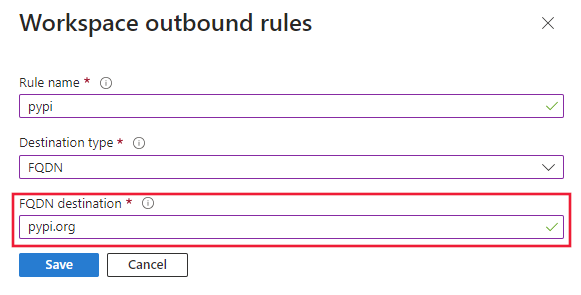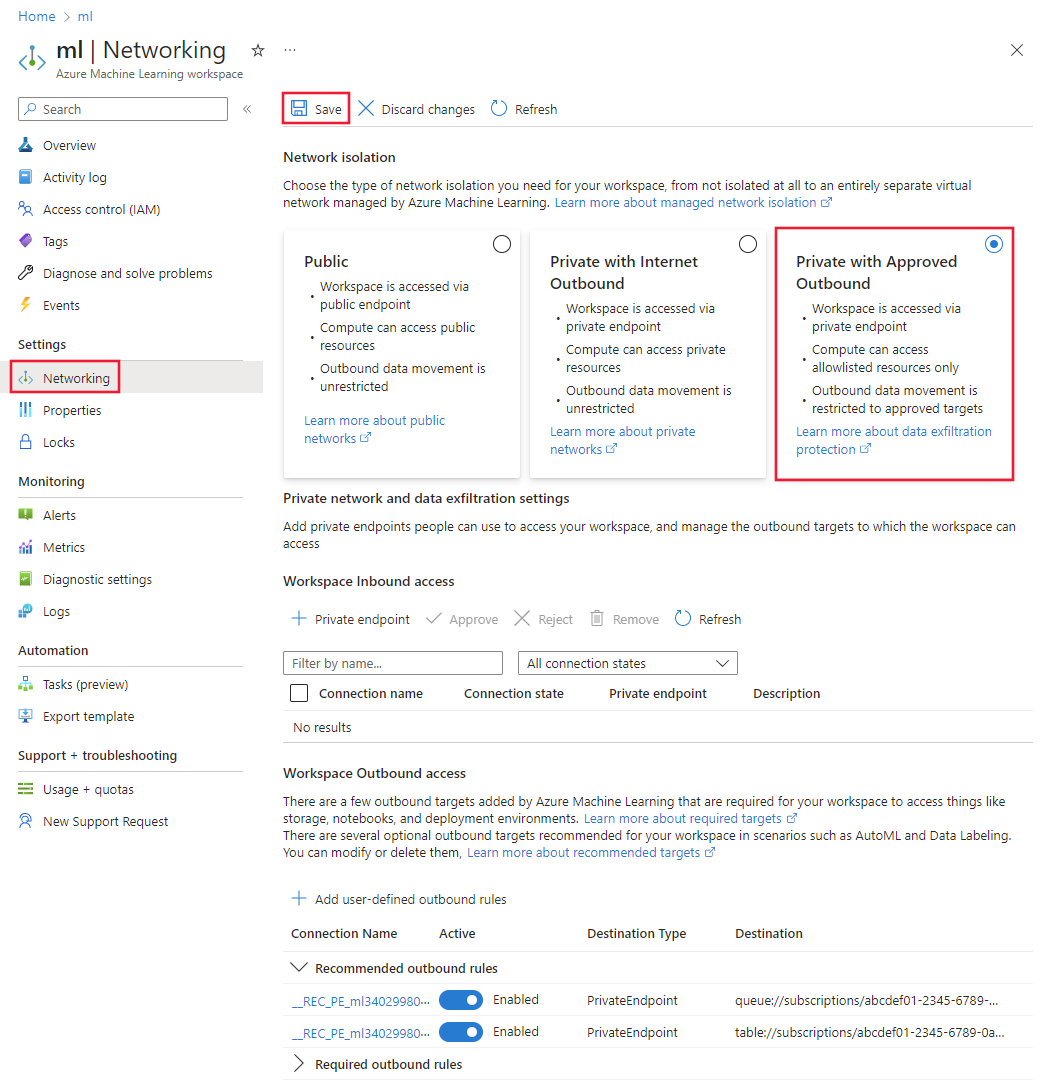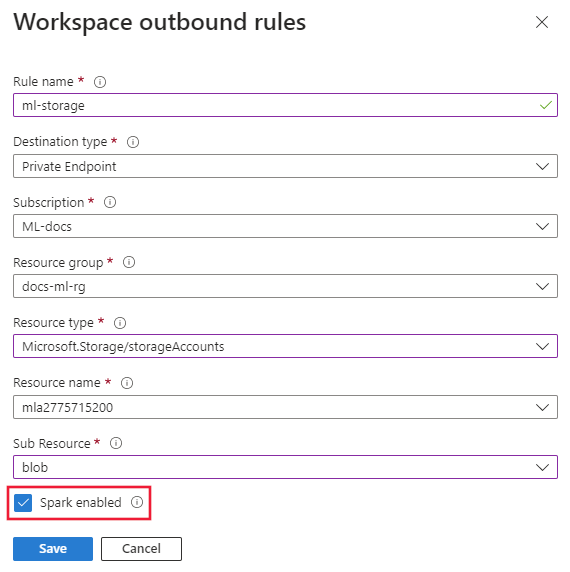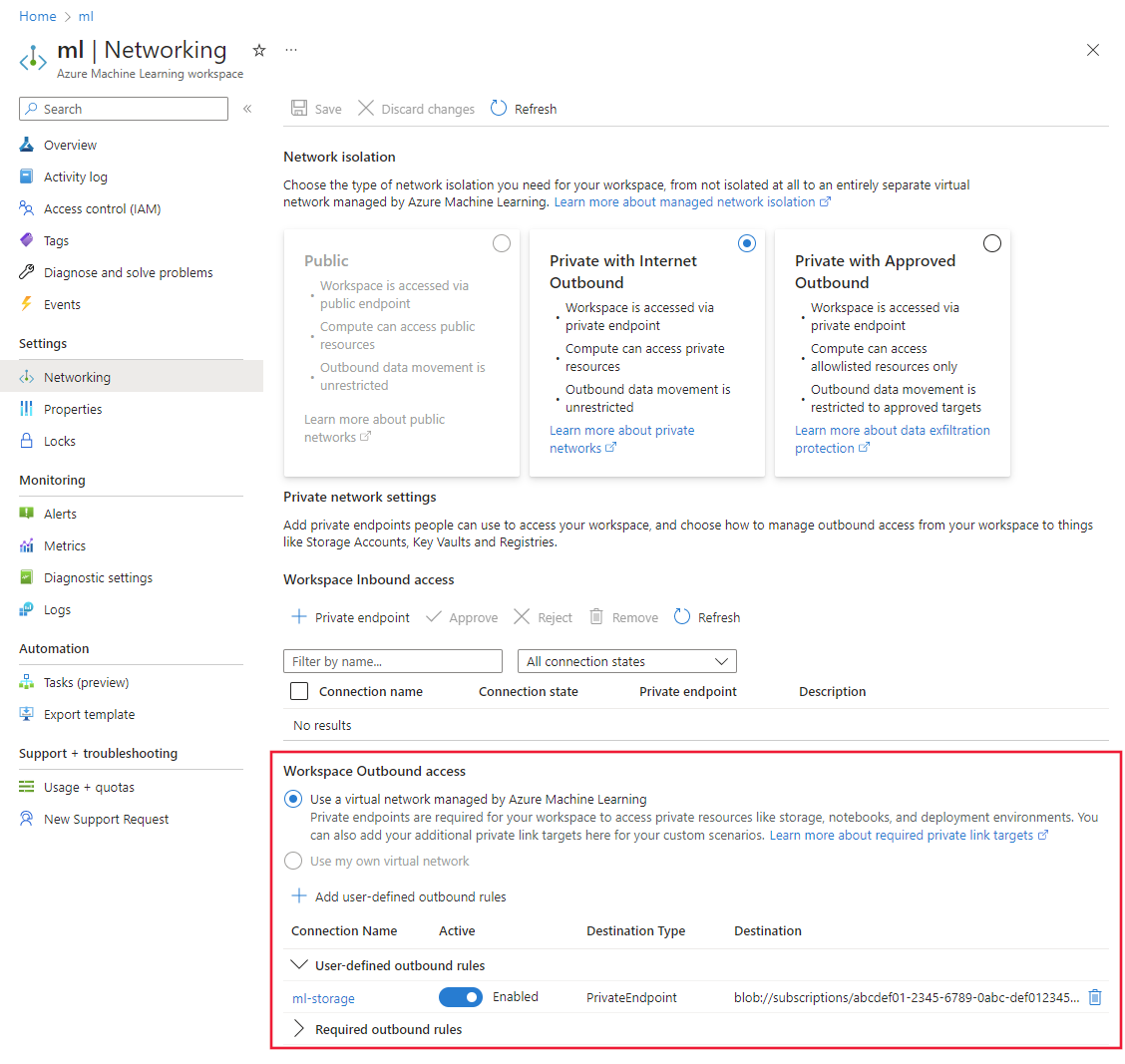Note
Access to this page requires authorization. You can try signing in or changing directories.
Access to this page requires authorization. You can try changing directories.
APPLIES TO:
 Azure CLI ml extension v2 (current)
Azure CLI ml extension v2 (current)
 Python SDK azure-ai-ml v2 (current)
Python SDK azure-ai-ml v2 (current)
Azure Machine Learning provides support for managed virtual network (managed virtual network) isolation. Managed virtual network isolation streamlines and automates your network isolation configuration with a built-in, workspace-level Azure Machine Learning managed virtual network. The managed virtual network secures your managed Azure Machine Learning resources, such as compute instances, compute clusters, serverless compute, and managed online endpoints.
Securing your workspace with a managed network provides network isolation for outbound access from the workspace and managed computes. An Azure Virtual Network that you create and manage is used to provide network isolation inbound access to the workspace. For example, a private endpoint for the workspace is created in your Azure Virtual Network. Any clients connecting to the virtual network can access the workspace through the private endpoint. When running jobs on managed computes, the managed network restricts what the compute can access.
Managed Virtual Network Architecture
When you enable managed virtual network isolation, a managed virtual network is created for the workspace. Managed compute resources you create for the workspace automatically use this managed virtual network. The managed virtual network can use private endpoints for Azure resources that are used by your workspace, such as Azure Storage, Azure Key Vault, and Azure Container Registry.
There are two different configuration modes for outbound traffic from the managed virtual network:
Tip
Regardless of the outbound mode you use, traffic to Azure resources can be configured to use a private endpoint. For example, you might allow all outbound traffic to the internet, but restrict communication with Azure resources by adding outbound rules for the resources.
| Outbound mode | Description | Scenarios |
|---|---|---|
| Allow internet outbound | Allow all internet outbound traffic from the managed virtual network. | You want unrestricted access to machine learning resources on the internet, such as python packages or pretrained models.1 |
| Allow only approved outbound | Outbound traffic is allowed by specifying service tags. | * You want to minimize the risk of data exfiltration, but you need to prepare all required machine learning artifacts in your private environment. * You want to configure outbound access to an approved list of services, service tags, or FQDNs. |
| Disabled | Inbound and outbound traffic isn't restricted or you're using your own Azure Virtual Network to protect resources. | You want public inbound and outbound from the workspace, or you're handling network isolation with your own Azure virtual network. |
- You can use outbound rules with allow only approved outbound mode to achieve the same result as using allow internet outbound. The differences are:
- You must add rules for each outbound connection you need to allow.
- Adding FQDN outbound rules increase your costs as this rule type uses Azure Firewall. For more information, see Pricing
- The default rules for allow only approved outbound are designed to minimize the risk of data exfiltration. Any outbound rules you add might increase your risk.
The managed virtual network is preconfigured with required default rules. It's also configured for private endpoint connections to your workspace, workspace's default storage, container registry, and key vault if they're configured as private or the workspace isolation mode is set to allow only approved outbound. After choosing the isolation mode, you only need to consider other outbound requirements you might need to add.
The following diagram shows a managed virtual network configured to allow internet outbound:
The following diagram shows a managed virtual network configured to allow only approved outbound:
Note
In this configuration, the storage, key vault, and container registry used by the workspace are flagged as private. Since they're flagged as private, a private endpoint is used to communicate with them.
Note
Once a managed VNet workspace is configured to allow internet outbound, the workspace can't be reconfigured to disabled. Similarly, once a managed VNet workspace is configured to allow only approved outbound, the workspace can't be reconfigured to allow internet outbound.
Azure Machine Learning studio
If you want to use the integrated notebook or create datasets in the default storage account from studio, your client needs access to the default storage account. Create a private endpoint or service endpoint for the default storage account in the Azure Virtual Network that the clients use.
Part of Azure Machine Learning studio runs locally in the client's web browser, and communicates directly with the default storage for the workspace. Creating a private endpoint or service endpoint (for the default storage account) in the client's virtual network ensures that the client can communicate with the storage account.
If the workspace associated Azure storage account has public network access disabled, ensure the private endpoint created in the client virtual network is granted the Reader role to your workspace managed identity. This applies to both blog and file storage private endpoints. The role isn't required for the private endpoint created by the managed virtual network.
For more information on creating a private endpoint or service endpoint, see the Connect privately to a storage account and Service Endpoints articles.
Secured associated resources
If you add the following services to the virtual network by using either a service endpoint or a private endpoint (disabling the public access), allow trusted Microsoft services to access these services:
| Service | Endpoint information | Allow trusted information |
|---|---|---|
| Azure Key Vault | Service endpoint Private endpoint |
Allow trusted Microsoft services to bypass this firewall |
| Azure Storage Account | Service and private endpoint Private endpoint |
Grant access from Azure resource instances or Grant access to trusted Azure services |
| Azure Container Registry | Private endpoint | Allow trusted services |
Prerequisites
Before following the steps in this article, make sure you have the following prerequisites:
An Azure subscription. If you don't have an Azure subscription, create a Trial before you begin. Try the free or paid version of Azure Machine Learning.
The Microsoft.Network resource provider must be registered for your Azure subscription. This resource provider is used by the workspace when creating private endpoints for the managed virtual network.
For information on registering resource providers, see Resolve errors for resource provider registration.
The Azure identity you use when deploying a managed network requires the following Azure role-based access control (Azure RBAC) actions to create private endpoints:
Microsoft.MachineLearningServices/workspaces/privateEndpointConnections/readMicrosoft.MachineLearningServices/workspaces/privateEndpointConnections/write
The Azure CLI and the
mlextension to the Azure CLI. For more information, see Install, set up, and use the CLI (v2).Tip
Azure Machine Learning managed VNet was introduced on May 23rd, 2023. If you have an older version of the ml extension, you might need to update it for the examples in this article work. To update the extension, use the following Azure CLI command:
az extension update -n mlThe CLI examples in this article assume that you're using the Bash (or compatible) shell. For example, from a Linux system or Windows Subsystem for Linux.
The Azure CLI examples in this article use
wsto represent the name of the workspace, andrgto represent the name of the resource group. Change these values as needed when using the commands with your Azure subscription.
An Azure subscription. If you don't have an Azure subscription, create a Trial before you begin. Try the free or paid version of Azure Machine Learning.
The Microsoft.Network resource provider must be registered for your Azure subscription. This resource provider is used by the workspace when creating private endpoints for the managed virtual network.
For information on registering resource providers, see Resolve errors for resource provider registration.
The Azure identity you use when deploying a managed network requires the following Azure role-based access control (Azure RBAC) actions to create private endpoints:
Microsoft.MachineLearningServices/workspaces/privateEndpointConnections/readMicrosoft.MachineLearningServices/workspaces/privateEndpointConnections/write
The Azure Machine Learning Python SDK v2. For more information on the SDK, see Install the Python SDK v2 for Azure Machine Learning.
Tip
Azure Machine Learning managed VNet was introduced on May 23rd, 2023. If you have an older version of the SDK installed, you might need to update it for the examples in this article to work. To update the SDK, use the following command:
pip install --upgrade azure-ai-ml azure-identityThe examples in this article assume that your code begins with the following Python. This code imports the classes required when creating a workspace with managed virtual network, sets variables for your Azure subscription and resource group, and creates the
ml_client:from azure.ai.ml import MLClient from azure.ai.ml.entities import ( Workspace, ManagedNetwork, IsolationMode, ServiceTagDestination, PrivateEndpointDestination, FqdnDestination ) from azure.identity import DefaultAzureCredential # Replace with the values for your Azure subscription and resource group. subscription_id = "<SUBSCRIPTION_ID>" resource_group = "<RESOURCE_GROUP>" # get a handle to the subscription ml_client = MLClient(DefaultAzureCredential(), subscription_id=subscription_id, resource_group_name=resource_group)
An Azure subscription. If you don't have an Azure subscription, create a Trial before you begin. Try the free or paid version of Azure Machine Learning.
The Microsoft.Network resource provider must be registered for your Azure subscription. This resource provider is used by the workspace when creating private endpoints for the managed virtual network.
For information on registering resource providers, see Resolve errors for resource provider registration.
The Azure identity you use when deploying a managed network requires the following Azure role-based access control (Azure RBAC) actions to create private endpoints:
Microsoft.MachineLearningServices/workspaces/privateEndpointConnections/readMicrosoft.MachineLearningServices/workspaces/privateEndpointConnections/write
To establish private endpoint connections in managed virtual networks using Azure Machine Learning, the workspace managed identity, whether system-assigned or user-assigned, and the user identity that initiates the creation of the private endpoint, must have permissions to approve the Private Endpoint connections on the target resources. After April 30th, 2025, permissions aren't automatically granted to the managed identity and must be assigned manually.
Microsoft recommends assigning the Azure AI Enterprise Network Connection Approver role to the managed identity. The following list contains the private endpoint target resource types covered by the Azure AI Enterprise Network Connection Approver role:
- Azure Application Gateway
- Azure Monitor
- Azure AI Search
- Event Hubs
- Azure SQL Database
- Azure Storage
- Azure Machine Learning workspace
- Azure Machine Learning registry
- Azure Key Vault
- Azure Cosmos DB
- Azure Database for MySQL
- Azure Database for PostgreSQL
- Foundry Tools
- Azure Cache for Redis
- Container Registry
- API Management
If you would like to create a custom role instead, see Azure AI Enterprise Network Connection Approver role to add the specific actions for each resource type.
To create private endpoint outbound rules to target resource types not covered by the Azure AI Enterprise Network Connection Approver role, a custom scoped-down role is recommended. The role should be defined with the actions necessary to approve private endpoint connections on the target resource types. Examples of such resource types are Azure Data Factory, Azure Databricks, and Azure Function Apps.
To create Private Endpoint outbound rules to default workspace resources, the required permissions are automatically covered by the role assignments granted during workspace creation, so no other action is needed.
Configure a managed virtual network to allow internet outbound
Tip
The creation of the managed VNet is deferred until a compute resource is created or provisioning is manually started. When you allow automatic creation, it can take around 30 minutes to create the first compute resource as it is also provisioning the network. For more information, see Manually provision the network.
Important
If you plan to submit serverless Spark jobs, you must manually start provisioning. For more information, see the configure for serverless Spark jobs section.
To configure a managed virtual network that allows internet outbound communications, you can use either the --managed-network allow_internet_outbound parameter or a YAML configuration file that contains the following entries:
managed_network:
isolation_mode: allow_internet_outbound
You can also define outbound rules to other Azure services that the workspace relies on. These rules define private endpoints that allow an Azure resource to securely communicate with the managed virtual network. The following rule demonstrates adding a private endpoint to an Azure Blob resource.
managed_network:
isolation_mode: allow_internet_outbound
outbound_rules:
- name: added-perule
destination:
service_resource_id: /subscriptions/<SUBSCRIPTION_ID>/resourceGroups/<RESOURCE_GROUP>/providers/Microsoft.Storage/storageAccounts/<STORAGE_ACCOUNT_NAME>
spark_enabled: true
subresource_target: blob
type: private_endpoint
You can configure a managed virtual network using either the az ml workspace create or az ml workspace update commands:
The following example creates a new workspace. The --managed-network allow_internet_outbound parameter configures a managed virtual network for the workspace:
az ml workspace create --name ws --resource-group rg --managed-network allow_internet_outbound
To create a workspace using a YAML file instead, use the --file parameter and specify the YAML file that contains the configuration settings:
az ml workspace create --file workspace.yaml --resource-group rg --name ws
The following YAML example defines a workspace with a managed virtual network:
name: myworkspace
location: EastUS
managed_network:
isolation_mode: allow_internet_outbound
To configure a managed virtual network that allows internet outbound communications, use the ManagedNetwork class to define a network with IsolationMode.ALLOW_INTERNET_OUTBOUND. You can then use the ManagedNetwork object to create a new workspace or update an existing one. To define outbound rules to Azure services that the workspace relies on, use the PrivateEndpointDestination class to define a new private endpoint to the service.
The following example creates a new workspace named myworkspace, with an outbound rule named myrule that adds a private endpoint for an Azure Blob store:
# Basic managed VNet configuration
network = ManagedNetwork(IsolationMode.ALLOW_INTERNET_OUTBOUND)
# Workspace configuration
ws = Workspace(
name="myworkspace",
location="ChinaNorth3",
managed_network=network
)
# Example private endpoint outbound to a blob
rule_name = "myrule"
service_resource_id = "/subscriptions/<SUBSCRIPTION_ID>/resourceGroups/<RESOURCE_GROUP>/providers/Microsoft.Storage/storageAccounts/<STORAGE_ACCOUNT_NAME>"
subresource_target = "blob"
spark_enabled = True
# Add the outbound
ws.managed_network.outbound_rules = [PrivateEndpointDestination(
name=rule_name,
service_resource_id=service_resource_id,
subresource_target=subresource_target,
spark_enabled=spark_enabled)]
# Create the workspace
ws = ml_client.workspaces.begin_create(ws).result()
Sign in to the Azure portal, and choose Azure Machine Learning from Create a resource menu.
Provide the required information on the Basics tab.
From the Networking tab, select Private with Internet Outbound.
To add an outbound rule, select Add user-defined outbound rules from the Networking tab. From the Workspace outbound rules sidebar, provide the following information:
- Rule name: A name for the rule. The name must be unique for this workspace.
- Destination type: Private Endpoint is the only option when the network isolation is private with internet outbound. Azure Machine Learning managed virtual network doesn't support creating a private endpoint to all Azure resource types. For a list of supported resources, see the Private endpoints section.
- Subscription: The subscription that contains the Azure resource you want to add a private endpoint for.
- Resource group: The resource group that contains the Azure resource you want to add a private endpoint for.
- Resource type: The type of the Azure resource.
- Resource name: The name of the Azure resource.
- Sub Resource: The sub resource of the Azure resource type.
- Spark enabled: Select this option if you want to enable serverless Spark jobs for the workspace. This option is only available if the resource type is Azure Storage.
Select Save to save the rule. You can continue using Add user-defined outbound rules to add rules.
Continue creating the workspace as normal.
Configure a managed virtual network to allow only approved outbound
Tip
The managed VNet is automatically provisioned when you create a compute resource. When you allow automatic creation, it can take around 30 minutes to create the first compute resource as it is also provisioning the network. If you configured FQDN outbound rules, the first FQDN rule adds around 10 minutes to the provisioning time. For more information, see Manually provision the network.
Important
If you plan to submit serverless Spark jobs, you must manually start provisioning. For more information, see the configure for serverless Spark jobs section.
To configure a managed virtual network that allows only approved outbound communications, you can use either the --managed-network allow_only_approved_outbound parameter or a YAML configuration file that contains the following entries:
managed_network:
isolation_mode: allow_only_approved_outbound
You can also define outbound rules to define approved outbound communication. An outbound rule can be created for a type of service_tag, fqdn, and private_endpoint. The following rule demonstrates adding a private endpoint to an Azure Blob resource, a service tag to Azure Data Factory, and an FQDN to pypi.org:
Important
- Adding an outbound for a service tag or FQDN is only valid when the managed VNet is configured to
allow_only_approved_outbound. - If you add outbound rules, Microsoft can't guarantee data exfiltration.
Warning
FQDN outbound rules are implemented using Azure Firewall. If you use outbound FQDN rules, charges for Azure Firewall are added to your billing. For more information, see Pricing.
managed_network:
isolation_mode: allow_only_approved_outbound
outbound_rules:
- name: added-servicetagrule
destination:
port_ranges: 80, 8080
protocol: TCP
service_tag: DataFactory
type: service_tag
- name: add-fqdnrule
destination: 'pypi.org'
type: fqdn
- name: added-perule
destination:
service_resource_id: /subscriptions/<SUBSCRIPTION_ID>/resourceGroups/<RESOURCE_GROUP>/providers/Microsoft.Storage/storageAccounts/<STORAGE_ACCOUNT_NAME>
spark_enabled: true
subresource_target: blob
type: private_endpoint
You can configure a managed virtual network using either the az ml workspace create or az ml workspace update commands:
The following example uses the --managed-network allow_only_approved_outbound parameter to configure the managed virtual network:
az ml workspace create --name ws --resource-group rg --managed-network allow_only_approved_outbound
The following YAML file defines a workspace with a managed virtual network:
name: myworkspace
location: ChinaNorth3
managed_network:
isolation_mode: allow_only_approved_outbound
To create a workspace using the YAML file, use the --file parameter:
az ml workspace create --file workspace.yaml --resource-group rg --name ws
To configure a managed virtual network that allows only approved outbound communications, use the ManagedNetwork class to define a network with IsolationMode.ALLOw_ONLY_APPROVED_OUTBOUND. You can then use the ManagedNetwork object to create a new workspace or update an existing one. To define outbound rules, use the following classes:
| Destination | Class |
|---|---|
| Azure service that the workspace relies on | PrivateEndpointDestination |
| Azure service tag | ServiceTagDestination |
| Fully qualified domain name (FQDN) | FqdnDestination |
The following example creates a new workspace named myworkspace, with several outbound rules:
myrule- Adds a private endpoint for an Azure Blob store.datafactory- Adds a service tag rule to communicate with Azure Data Factory.
Important
- Adding an outbound for a service tag or FQDN is only valid when the managed VNet is configured to
IsolationMode.ALLOW_ONLY_APPROVED_OUTBOUND. - If you add outbound rules, Microsoft can't guarantee data exfiltration.
Warning
FQDN outbound rules are implemented using Azure Firewall. If you use outbound FQDN rules, charges for Azure Firewall are added to your billing. For more information, see Pricing.
# Basic managed VNet configuration
network = ManagedNetwork(IsolationMode.ALLOW_ONLY_APPROVED_OUTBOUND)
# Workspace configuration
ws = Workspace(
name="myworkspace",
location="ChinaNorth3",
managed_network=network
)
# Append some rules
ws.managed_network.outbound_rules = []
# Example private endpoint outbound to a blob
rule_name = "myrule"
service_resource_id = "/subscriptions/<SUBSCRIPTION_ID>/resourceGroups/<RESOURCE_GROUP>/providers/Microsoft.Storage/storageAccounts/<STORAGE_ACCOUNT_NAME>"
subresource_target = "blob"
spark_enabled = True
ws.managed_network.outbound_rules.append(
PrivateEndpointDestination(
name=rule_name,
service_resource_id=service_resource_id,
subresource_target=subresource_target,
spark_enabled=spark_enabled
)
)
# Example service tag rule
rule_name = "datafactory"
service_tag = "DataFactory"
protocol = "TCP"
port_ranges = "80, 8080-8089"
ws.managed_network.outbound_rules.append(
ServiceTagDestination(
name=rule_name,
service_tag=service_tag,
protocol=protocol,
port_ranges=port_ranges
)
)
# Example FQDN rule
ws.managed_network.outbound_rules.append(
FqdnDestination(
name="fqdnrule",
destination="pypi.org"
)
)
# Create the workspace
ws = ml_client.workspaces.begin_create(ws).result()
Sign in to the Azure portal, and choose Azure Machine Learning from Create a resource menu.
Provide the required information on the Basics tab.
From the Networking tab, select Private with Approved Outbound.
To add an outbound rule, select Add user-defined outbound rules from the Networking tab. From the Workspace outbound rules sidebar, provide the following information:
- Rule name: A name for the rule. The name must be unique for this workspace.
- Destination type: Private Endpoint, Service Tag, or FQDN. Service Tag and FQDN are only available when the network isolation is private with approved outbound.
If the destination type is Private Endpoint, provide the following information:
- Subscription: The subscription that contains the Azure resource you want to add a private endpoint for.
- Resource group: The resource group that contains the Azure resource you want to add a private endpoint for.
- Resource type: The type of the Azure resource.
- Resource name: The name of the Azure resource.
- Sub Resource: The sub resource of the Azure resource type.
- Spark enabled: Select this option if you want to enable serverless Spark jobs for the workspace. This option is only available if the resource type is Azure Storage.
Tip
Azure Machine Learning managed VNet doesn't support creating a private endpoint to all Azure resource types. For a list of supported resources, see the Private endpoints section.
If the destination type is Service Tag, provide the following information:
- Service tag: The service tag to add to the approved outbound rules.
- Protocol: The protocol to allow for the service tag.
- Port ranges: The port ranges to allow for the service tag.
If the destination type is FQDN, provide the following information:
Warning
FQDN outbound rules are implemented using Azure Firewall. If you use outbound FQDN rules, charges for Azure Firewall are added to your billing. For more information, see Pricing.
- FQDN destination: The fully qualified domain name to add to the approved outbound rules.
Select Save to save the rule. You can continue using Add user-defined outbound rules to add rules.
Continue creating the workspace as normal.
Configure for serverless Spark jobs
Tip
The steps in this section are only needed if you plan to submit serverless Spark jobs. If you aren't going to be submitting serverless Spark jobs, you can skip this section.
To enable the serverless Spark jobs for the managed virtual network, you must perform the following actions:
- Configure a managed virtual network for the workspace and add an outbound private endpoint for the Azure Storage Account.
- After you configure the managed virtual network, provision it and flag it to allow Spark jobs.
Configure an outbound private endpoint.
Use a YAML file to define the managed virtual network configuration and add a private endpoint for the Azure Storage Account. Also set
spark_enabled: true:Tip
This example is for a managed VNet configured using
isolation_mode: allow_internet_outboundto allow internet traffic. If you want to allow only approved outbound traffic, useisolation_mode: allow_only_approved_outbound.name: myworkspace managed_network: isolation_mode: allow_internet_outbound outbound_rules: - name: added-perule destination: service_resource_id: /subscriptions/<SUBSCRIPTION_ID>/resourceGroups/<RESOURCE_GROUP>/providers/Microsoft.Storage/storageAccounts/<STORAGE_ACCOUNT_NAME> spark_enabled: true subresource_target: blob type: private_endpointYou can use a YAML configuration file with the
az ml workspace updatecommand by specifying the--fileparameter and the name of the YAML file. For example, the following command updates an existing workspace using a YAML file namedworkspace_pe.yml:az ml workspace update --file workspace_pe.yml --resource_group rg --name wsNote
When Allow Only Approved Outbound is enabled (
isolation_mode: allow_only_approved_outbound), conda package dependencies defined in Spark session configuration fails to install. To resolve this problem, upload a self-contained Python package wheel with no external dependencies to an Azure storage account and create private endpoint to this storage account. Use the path to Python package wheel aspy_filesparameter in your Spark job. Setting an FQDN outbound rule won't bypass this issue as FQDN rule propagation isn't supported by Spark.The following example demonstrates how to create a managed virtual network for an existing Azure Machine Learning workspace named
myworkspace. It also adds a private endpoint for the Azure Storage Account and setsspark_enabled=true:Tip
The following example is for a managed VNet configured using
IsolationMode.ALLOW_INTERNET_OUTBOUNDto allow internet traffic. If you want to allow only approved outbound traffic, useIsolationMode.ALLOW_ONLY_APPROVED_OUTBOUND.# Get the existing workspace ml_client = MLClient(DefaultAzureCredential(), subscription_id, resource_group, "myworkspace") ws = ml_client.workspaces.get() # Basic managed VNet configuration ws.managed_network = ManagedNetwork(IsolationMode.ALLOW_INTERNET_OUTBOUND) # Example private endpoint outbound to a blob rule_name = "myrule" service_resource_id = "/subscriptions/<SUBSCRIPTION_ID>/resourceGroups/<RESOURCE_GROUP>/providers/Microsoft.Storage/storageAccounts/<STORAGE_ACCOUNT_NAME>" subresource_target = "blob" spark_enabled = True # Add the outbound ws.managed_network.outbound_rules = [PrivateEndpointDestination( name=rule_name, service_resource_id=service_resource_id, subresource_target=subresource_target, spark_enabled=spark_enabled)] # Create the workspace ml_client.workspaces.begin_update(ws)Note
- When Allow Only Approved Outbound is enabled (
isolation_mode: allow_only_approved_outbound), conda package dependencies defined in Spark session configuration fails to install. To resolve this problem, upload a self-contained Python package wheel with no external dependencies to an Azure storage account and create private endpoint to this storage account. Use the path to Python package wheel aspy_filesparameter in the Spark job. - If the workspace was created with
IsolationMode.ALLOW_INTERNET_OUTBOUND, it can’t be updated later to useIsolationMode.ALLOW_ONLY_APPROVED_OUTBOUND.
Sign in to the Azure portal, and select the Azure Machine Learning workspace.
Select Networking, then select Add user-defined outbound rules. Add a rule for the Azure Storage Account, and make sure that Spark enabled is selected.
Select Save to save the rule, then select Save from the top of Networking to save the changes to the managed virtual network.
- When Allow Only Approved Outbound is enabled (
Provision the managed virtual network.
Note
If your workspace has public network access enabled, you must disable it before provisioning the managed VNet. If you don't disable public network access when provisioning the managed VNet, the private endpoints for the workspace might not be created automatically in the managed VNet. Otherwise, you would have to manually configure the private endpoint outbound rule for the workspace after the provisioning.
The following example shows how to provision a managed virtual network for serverless Spark jobs by using the
--include-sparkparameter.az ml workspace provision-network -g my_resource_group -n my_workspace_name --include-sparkThe following example shows how to provision a managed virtual network for serverless Spark jobs:
# Connect to a workspace named "myworkspace" ml_client = MLClient(DefaultAzureCredential(), subscription_id=subscription_id, resource_group_name=resource_group, workspace_name="myworkspace") # whether to provision Spark vnet as well include_spark = True provision_network_result = ml_client.workspaces.begin_provision_network(workspace_name=ws_name, include_spark=include_spark).result()From the Azure portal, you can only select to provision the managed network during workspace creation. To do so, select Provision managed virtual network from the Outbound access tab. To provision the managed network for serverless Spark jobs for an existing workspace, you must use the Azure CLI or Python SDK.
Manually provision a managed VNet
The managed virtual network is automatically provisioned when you create a compute instance. When you rely on automatic provisioning, it can take around 30 minutes to create the first compute instance as it is also provisioning the network. If you configured FQDN outbound rules (only available with allow only approved mode), the first FQDN rule adds around 10 minutes to the provisioning time. If you have a large set of outbound rules to be provisioned in the managed network, it can take longer for provisioning to complete. The increased provisioning time can cause your first compute instance creation to time out.
To reduce the wait time and avoid potential timeout errors, we recommend manually provisioning the managed network. Then wait until the provisioning completes before you create a compute instance.
Alternatively, you can use the provision_network_now flag to provision the managed network as part of workspace creation.
Note
To create an online deployment, you must manually provision the managed network, or create a compute instance first which will automatically provision it.
The following example shows how to provision a managed virtual network during workspace creation.
az ml workspace create -n myworkspace -g my_resource_group --managed-network AllowInternetOutbound --provision-network-now
The following example shows how to manually provision a managed virtual network.
Tip
If you plan to submit serverless Spark jobs, add the --include-spark parameter.
az ml workspace provision-network -g my_resource_group -n my_workspace_name
To verify that the provisioning completed, use the following command:
az ml workspace show -n my_workspace_name -g my_resource_group --query managed_network
To provision the managed network during workspace creation, set the provision_network_now flag to True.
provision_network_now: True
The following example shows how to provision a managed virtual network:
# Connect to a workspace named "myworkspace"
ml_client = MLClient(DefaultAzureCredential(), subscription_id=subscription_id, resource_group_name=resource_group, workspace_name="myworkspace")
# whether to provision Spark vnet as well
include_spark = True
provision_network_result = ml_client.workspaces.begin_provision_network(workspace_name=ws_name, include_spark=include_spark).result()
To verify that the workspace has been provisioned, use ml_client.workspaces.get() to get the workspace information. The managed_network property contains the status of the managed network.
ws = ml_client.workspaces.get()
print(ws.managed_network.status)
During workspace creation, select Provision managed network proactively at creation to provision the managed network. Charges are incurred from network resources, such as private endpoints, once the virtual network is provisioned. This configuration option is only available during workspace creation.
Configure image builds
When the Azure Container Registry for your workspace is behind a virtual network, it can't be used to directly build Docker images. Instead, configure your workspace to use a compute cluster or compute instance to build images.
Important
The compute resource used to build Docker images needs to be able to access the package repositories that are used to train and deploy your models. If you're using a network configured to allow only approved outbound, you might need to add rules that allow access to public repos or use private Python packages.
To update a workspace to use a compute cluster or compute instance to build Docker images, use the az ml workspace update command with the --image-build-compute parameter:
az ml workspace update --name ws --resource-group rg --image-build-compute mycompute
The following example demonstrates how to update a workspace to use a compute cluster to build images:
# import required libraries
from azure.ai.ml import MLClient
from azure.identity import DefaultAzureCredential
subscription_id = "<your subscription ID>"
resource_group = "<your resource group name>"
workspace = "<your workspace name>"
ml_client = MLClient(
DefaultAzureCredential(), subscription_id=subscription_id, resource_group_name=resource_group, workspace_name=workspace
)
# Get workspace info
ws=ml_client.workspaces.get(name=workspace)
# Update to use cpu-cluster for image builds
ws.image_build_compute="mycompute"
ml_client.workspaces.begin_update(ws)
# To switch back to using ACR to build (if ACR is not in the virtual network):
# ws.image_build_compute = ''
# ml_client.workspaces.begin_update(ws)
There isn't a way to set the image build compute from the Azure portal. Instead, use the Azure CLI or Python SDK.
Manage outbound rules
To list the managed virtual network outbound rules for a workspace, use the following command:
az ml workspace outbound-rule list --workspace-name ws --resource-group rg
To view the details of a managed virtual network outbound rule, use the following command:
az ml workspace outbound-rule show --rule rule-name --workspace-name ws --resource-group rg
To remove an outbound rule from the managed virtual network, use the following command:
az ml workspace outbound-rule remove --rule rule-name --workspace-name ws --resource-group rg
The following example demonstrates how to manage outbound rules for a workspace named myworkspace:
# Connect to the workspace
ml_client = MLClient(DefaultAzureCredential(), subscription_id=subscription_id, resource_group_name=resource_group, workspace_name="myworkspace")
# Specify the rule name
rule_name = "<some-rule-name>"
# Get a rule by name
rule = ml_client._workspace_outbound_rules.get(resource_group, ws_name, rule_name)
# List rules for a workspace
rule_list = ml_client._workspace_outbound_rules.list(resource_group, ws_name)
# Delete a rule from a workspace
ml_client._workspace_outbound_rules.begin_remove(resource_group, ws_name, rule_name).result()
Sign in to the Azure portal, and select the Azure Machine Learning workspace that you want to enable managed virtual network isolation for.
Select Networking. The Workspace Outbound access section allows you to manage outbound rules.
To add an outbound rule, select Add user-defined outbound rules from the Networking tab. From the Workspace outbound rules sidebar, provide the following information:
To enable or disable a rule, use the toggle in the Active column.
To delete an outbound rule, select delete for the rule.
List of required rules
Private endpoints:
- When the isolation mode for the managed virtual network is
Allow internet outbound, private endpoint outbound rules are automatically created as required rules from the managed virtual network for the workspace and associated resources with public network access disabled (Key Vault, Storage Account, Container Registry, Azure Machine Learning workspace). - When the isolation mode for the managed virtual network is
Allow only approved outbound, private endpoint outbound rules are automatically created as required rules from the managed virtual network for the workspace and associated resources regardless of public network access mode for those resources (Key Vault, Storage Account, Container Registry, Azure Machine Learning workspace). - These rules are automatically added to the managed virtual network.
For Azure Machine Learning to run normally, there are a set of required service tags, required in either a managed or custom virtual network set-up. There are no alternatives to replacing certain required service tags. The following table describes each required service tag and its purpose within Azure Machine Learning.
| Service tag rule | Inbound or Outbound | Purpose |
|---|---|---|
AzureMachineLearning |
Inbound | Create, update, and delete of Azure Machine Learning compute instance/cluster. |
AzureMachineLearning |
Outbound | Using Azure Machine Learning services. Python intellisense in notebooks uses port 18881. Creating, updating, and deleting an Azure Machine Learning compute instance uses port 5831. |
AzureActiveDirectory |
Outbound | Authentication using Microsoft Entra ID. |
BatchNodeManagement.region |
Outbound | Communication with Azure Batch back-end for Azure Machine Learning compute instances/clusters. |
AzureResourceManager |
Outbound | Creation of Azure resources with Azure Machine Learning, Azure CLI, and Azure Machine Learning SDK. |
AzureFrontDoor.FirstParty |
Outbound | Access docker images provided by Microsoft. |
MicrosoftContainerRegistry |
Outbound | Access docker images provided by Microsoft. Setup of the Azure Machine Learning router for Azure Kubernetes Service. |
AzureMonitor |
Outbound | Used to log monitoring and metrics to Azure Monitor. Only needed if the Azure Monitor for the workspace isn't secured. This outbound is also used to log information for support incidents. |
VirtualNetwork |
Outbound | Required when private endpoints are present in the virtual network or peered virtual networks. |
Note
Service tags as the ONLY security boundary isn't sufficient. For tenant level isolation, use private endpoints when possible.
List of scenario specific outbound rules
Scenario: Access public machine learning packages
To allow installation of Python packages for training and deployment, add outbound FQDN rules to allow traffic to the following host names:
Warning
FQDN outbound rules are implemented using Azure Firewall. If you use outbound FQDN rules, charges for Azure Firewall are added to your billing. For more information, see Pricing.
Note
The following list doesn't contain all of the hosts required for all Python resources on the internet, only the most commonly used. For example, if you need access to a GitHub repository or other host, you must identify and add the required hosts for that scenario.
| Host name | Purpose |
|---|---|
anaconda.com*.anaconda.com |
Used to install default packages. |
*.anaconda.org |
Used to get repo data. |
pypi.org |
Used to list dependencies from the default index, if any, and the index isn't overwritten by user settings. If the index is overwritten, you must also allow *.pythonhosted.org. |
pytorch.org*.pytorch.org |
Used by some examples based on PyTorch. |
*.tensorflow.org |
Used by some examples based on TensorFlow. |
Scenario: Use Visual Studio Code desktop or web with compute instance
If you plan to use Visual Studio Code with Azure Machine Learning, add outbound FQDN rules to allow traffic to the following hosts:
Note
The following list isn't a complete list of the hosts required for all Visual Studio Code resources on the internet, only the most commonly used. For example, if you need access to a GitHub repository or other host, you must identify and add the required hosts for that scenario. For a complete list of host names, see Network Connections in Visual Studio Code.
| Host name | Purpose |
|---|---|
*.vscode.dev*.vscode-unpkg.net*.vscode-cdn.net*.vscodeexperiments.azureedge.netdefault.exp-tas.com |
Required to access vscode.dev (Visual Studio Code for the Web) |
code.visualstudio.com |
Required to download and install VS Code desktop. This host isn't required for VS Code Web. |
update.code.visualstudio.com*.vo.msecnd.net |
Used to retrieve VS Code server bits that are installed on the compute instance through a setup script. |
marketplace.visualstudio.comvscode.blob.core.chinacloudapi.cn*.gallerycdn.vsassets.io |
Required to download and install VS Code extensions. These hosts enable the remote connection to compute instances. For more information, see Manage Azure Machine Learning resources in VS Code. |
vscode.download.prss.microsoft.com |
Used for Visual Studio Code download CDN |
Scenario: Use batch endpoints or ParallelRunStep
If you plan to use Azure Machine Learning batch endpoints for deployment or ParallelRunStep, add outbound private endpoint rules to allow traffic to the following sub resources for the default storage account:
queuetable
Scenario: Use prompt flow with Azure OpenAI, content safety, and Azure AI Search
- Private endpoint to Foundry Tools
- Private endpoint to Azure AI Search
Scenario: Use HuggingFace models
If you plan to use HuggingFace models with Azure Machine Learning, add outbound FQDN rules to allow traffic to the following hosts:
Warning
FQDN outbound rules are implemented using Azure Firewall. If you use outbound FQDN rules, charges for Azure Firewall are added to your billing. For more information, see Pricing.
docker.io*.docker.io*.docker.comproduction.cloudflare.docker.comcdn.auth0.comcdn-lfs.huggingface.co
Scenario: Enable access from selected IP Addresses
If you want to enable access from specific IP addresses, use the following actions:
Add an outbound private endpoint rule to allow traffic to the Azure Machine Learning workspace. This rule allows compute instances created in the managed virtual network to access the workspace.
Tip
You can't add this rule during workspace creation, as the workspace doesn't exist yet.
Enable public network access to the workspace. For more information, see public network access enabled.
Add your IP addresses to the firewall for Azure Machine Learning. For more information, see enable access only from IP ranges.
Note
Only IPv4 addresses are supported.
For more information, see Configure private link.
Private endpoints
Private endpoints are currently supported for the following Azure services:
- Azure Machine Learning
- Azure Machine Learning registries
- Azure Storage (all sub resource types)
- Azure Container Registry
- Azure Key Vault
- Foundry Tools
- Azure AI Search (formerly Cognitive Search)
- Azure SQL Server
- Azure Data Factory
- Azure Cosmos DB (all sub resource types)
- Azure Event Hubs
- Azure Redis Cache
- Azure Databricks
- Azure Database for MariaDB
- Azure Database for PostgreSQL Single Server
- Azure Database for PostgreSQL Flexible Server
- Azure Database for MySQL
- Azure API Management
When you create a private endpoint, you provide the resource type and subresource that the endpoint connects to. Some resources have multiple types and subresources. For more information, see what is a private endpoint.
When you create a private endpoint for Azure Machine Learning dependency resources, such as Azure Storage, Azure Container Registry, and Azure Key Vault, the resource can be in a different Azure subscription. However, the resource must be in the same tenant as the Azure Machine Learning workspace.
Pricing
The Azure Machine Learning managed virtual network feature is free. However, you're charged for the following resources that are used by the managed virtual network:
Azure Private Link - Private endpoints used to secure communications between the managed virtual network and Azure resources relies on Azure Private Link. For more information on pricing, see Azure Private Link pricing.
FQDN outbound rules - FQDN outbound rules are implemented using Azure Firewall. If you use outbound FQDN rules, charges for Azure Firewall are added to your billing. A standard version of Azure Firewall is used by default. For information on selecting the basic version, see Select an Azure Firewall version.
Important
The firewall isn't created until you add an outbound FQDN rule. For more information on pricing, see Azure Firewall pricing and view prices for the standard version.
Limitations
- Once you enable managed virtual network isolation of your workspace (either allow internet outbound or allow only approved outbound), you can't disable it.
- Managed virtual network uses private endpoint connection to access your private resources. You can't have a private endpoint and a service endpoint at the same time for your Azure resources, such as a storage account. We recommend using private endpoints in all scenarios.
- The managed virtual network is deleted when the workspace is deleted.
- Make sure there are no scope locks on the Azure Machine Learning resources and resource group. Internal operations related to managed virtual network might be blocked.
- Data exfiltration protection is automatically enabled for the only approved outbound mode. If you add other outbound rules, such as to FQDNs, Microsoft can't guarantee that you're protected from data exfiltration to those outbound destinations.
- Creating a compute cluster in a different region than the workspace isn't supported when using a managed virtual network.
- Kubernetes and attached VMs aren't supported in an Azure Machine Learning managed virtual network.
- Using FQDN outbound rules increases the cost of the managed virtual network because FQDN rules use Azure Firewall. For more information, see Pricing.
- FQDN outbound rules only support ports 80 and 443.
- If your compute instance is in a managed network and is configured for no public IP, use the
az ml compute connect-sshcommand to connect to it using SSH. - When using Managed virtual network, you can't deploy compute resources inside your custom virtual network. Compute resources can only be created inside the managed virtual network.
- If your managed network is configured to allow only approved outbound, you can't use an FQDN rule to access Azure Storage Accounts. You must use a private endpoint instead.
- Ensure to allowlist Azure-managed private endpoints created for the managed virtual network in your custom policy.
Migration of compute resources
If you have an existing workspace and want to enable managed virtual network for it, there's currently no supported migration path for existing managed compute resources. You'll need to delete all existing managed compute resources and recreate them after enabling the managed virtual network. The following list contains the compute resources that must be deleted and recreated:
- Compute cluster
- Compute instance
- Managed online endpoints
